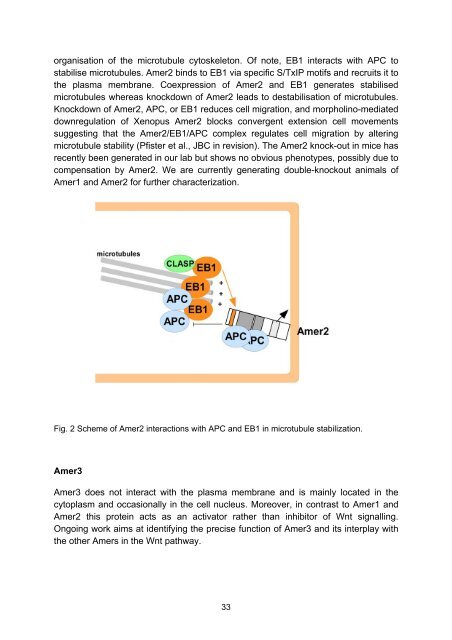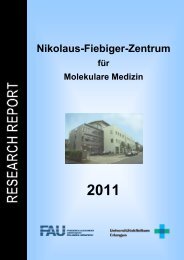Research Report - Nikolaus-Fiebiger-Zentrum für Molekulare Medizin
Research Report - Nikolaus-Fiebiger-Zentrum für Molekulare Medizin
Research Report - Nikolaus-Fiebiger-Zentrum für Molekulare Medizin
Create successful ePaper yourself
Turn your PDF publications into a flip-book with our unique Google optimized e-Paper software.
organisation of the microtubule cytoskeleton. Of note, EB1 interacts with APC to<br />
stabilise microtubules. Amer2 binds to EB1 via specific S/TxIP motifs and recruits it to<br />
the plasma membrane. Coexpression of Amer2 and EB1 generates stabilised<br />
microtubules whereas knockdown of Amer2 leads to destabilisation of microtubules.<br />
Knockdown of Amer2, APC, or EB1 reduces cell migration, and morpholino-mediated<br />
downregulation of Xenopus Amer2 blocks convergent extension cell movements<br />
suggesting that the Amer2/EB1/APC complex regulates cell migration by altering<br />
microtubule stability (Pfister et al., JBC in revision). The Amer2 knock-out in mice has<br />
recently been generated in our lab but shows no obvious phenotypes, possibly due to<br />
compensation by Amer2. We are currently generating double-knockout animals of<br />
Amer1 and Amer2 for further characterization.<br />
Fig. 2 Scheme of Amer2 interactions with APC and EB1 in microtubule stabilization.<br />
Amer3<br />
Amer3 does not interact with the plasma membrane and is mainly located in the<br />
cytoplasm and occasionally in the cell nucleus. Moreover, in contrast to Amer1 and<br />
Amer2 this protein acts as an activator rather than inhibitor of Wnt signalling.<br />
Ongoing work aims at identifying the precise function of Amer3 and its interplay with<br />
the other Amers in the Wnt pathway.<br />
33



